Transport Mechanism of Enhanced Performance in an Amorphous/Monoclinic Mixed-Phase Ga2O3 Solar-Blind Deep Ultraviolet Photodetector
Abstract
:1. Introduction
2. Experimental Details
3. Results and Discussion
4. Conclusions
Supplementary Materials
Author Contributions
Funding
Institutional Review Board Statement
Informed Consent Statement
Data Availability Statement
Acknowledgments
Conflicts of Interest
References
- Pearton, S.J.; Yang, J.; Cary, P.H.; Ren, F.; Kim, J.; Tadjer, M.J.; Mastro, M.A. A review of Ga2O3 materials, processing, and devices. Appl. Phys. Rev. 2018, 5, 011301. [Google Scholar] [CrossRef] [Green Version]
- Xu, J.; Zheng, W.; Huang, F. Gallium Oxide Solar-Blind Ultraviolet Photodetector: A Review. J. Mater. Chem. C 2019, 7, 8753–8770. [Google Scholar] [CrossRef]
- Xie, C.; Lu, X.; Tong, X.; Zhang, Z.; Liang, F.; Liang, L.; Luo, L.; Wu, Y. Recent Progress in Solar-Blind Deep-Ultraviolet Photodetectors Based on Inorganic Ultrawide Bandgap Semiconductors. Adv. Funct. Mater. 2019, 29, 1806006. [Google Scholar] [CrossRef]
- Chen, X.; Ren, F.; Gu, S.; Ye, J. Review of gallium-oxide-based solar-blind ultraviolet photodetectors. Photonics Res. 2019, 7, 381–415. [Google Scholar] [CrossRef]
- Hou, X.H.; Zou, Y.N.; Ding, M.F.; Qin, Y.; Zhang, Z.F.; Ma, X.L.; Tan, P.J.; Yu, S.J.; Zhou, X.Z.; Zhao, X.L.; et al. Review of polymorphous Ga2O3 materials and their solar-blind photodetector applications. J. Phys. D Appl. Phys. 2021, 54, 043001. [Google Scholar] [CrossRef]
- Liang, H.L.; Han, Z.Y.; Mei, Z.X. Recent Progress of Deep Ultraviolet Photodetectors using Amorphous Gallium Oxide Thin Films. Phys. Status Solidi A 2021, 218, 2000339. [Google Scholar] [CrossRef]
- Monroy, E.; Omnès, F.; Calle, F. Wide-bandgap semiconductor ultraviolet photodetectors. Semicond. Sci. Technol. 2003, 18, R33–R51. [Google Scholar] [CrossRef]
- Qin, Y.; Li, L.; Zhao, X.; Tompa, G.S.; Dong, H.; Jian, G.; He, Q.M.; Tan, P.; Hou, X.; Zhang, Z.; et al. Metal-Semiconductor-Metal ε-Ga2O3 Solar-Blind Photodetectors with a Record-High Responsivity Rejection Ratio and Their Gain Mechanism. ACS Photonics 2020, 7, 812–820. [Google Scholar] [CrossRef]
- Zhang, H.C.; Liang, F.Z.; Song, K.; Xing, C.; Wang, D.H.; Yu, H.B.; Huang, C.; Sun, Y.; Yang, L.; Zhao, X.L.; et al. Demonstration of AlGaN/GaN-based ultraviolet phototransistor with a record high responsivity over 3.6 × 107 A/W. Appl. Phys. Lett. 2021, 118, 242105. [Google Scholar] [CrossRef]
- Fan, M.M.; Liu, K.W.; Chen, X.; Wang, X.; Zhang, Z.Z.; Li, B.H.; Shen, D.Z. Mechanism of Excellent Photoelectric Characteristics in Mixed-Phase ZnMgO Ultraviolet Photodetectors with Single Cutoff Wavelength. ACS Appl. Mater. Interfaces 2015, 7, 20600–20606. [Google Scholar] [CrossRef]
- Chen, Y.; Lu, Y.; Lin, C.; Tian, Y.; Gao, C.; Dong, L.; Shan, C. Self-powered diamond/β-Ga2O3 photodetectors for solar-blind imaging. J. Mater. Chem. C 2018, 6, 5727–5732. [Google Scholar] [CrossRef]
- Chikoidze, E.; Tchelidze, T.; Sartel, C.; Chi, Z.; Kabouche, R.; Madaci, I.; Rubio, C.; Mohamed, H.; Sallet, V.; Medjdoub, F.; et al. Ultra-high critical electric field of 13.2 MV/cm for Zn-doped p-type β-Ga2O3. Mater. Today Phys. 2020, 15, 100263. [Google Scholar] [CrossRef]
- Feng, W.; Wang, X.N.; Zhang, J.; Wang, L.F.; Zheng, W.; Hu, P.A.; Cao, W.W.; Yang, B. Synthesis of two-dimensional β-Ga2O3 nanosheets for high-performance solar blind photodetectors. J. Mater. Chem. C 2014, 2, 3254–3259. [Google Scholar] [CrossRef]
- Zhang, D.; Zheng, W.; Lin, R.C.; Li, T.T.; Zhang, Z.J.; Huang, F. High quality β-Ga2O3 film grown with N2O for high sensitivity solar-blind-ultraviolet photodetector with fast response speed. J. Alloys Compd. 2018, 735, 150–154. [Google Scholar] [CrossRef]
- Zhang, M.M.; Kang, S.; Zhang, K.; Wu, Y.T.; Feng, S.L.; Lu, W.Q. Facile Synthesis of β-Ga2O3 nanowires network for solar-blind ultraviolet photodetector. J. Phys. D: Appl. Phys. 2021, 54, 175106. [Google Scholar] [CrossRef]
- Hou, X.H.; Sun, H.D.; Long, S.B.; Tompa, G.S.; Salagaj, T.; Qin, Y.; Zhang, Z.F.; Tan, P.J.; Yu, S.J.; Liu, M. Ultrahigh-Performance Solar-Blind Photodetector Based on α-Phase-Dominated Ga2O3 Film With Record Low Dark Current of 81 fA. IEEE Electron. Device Lett. 2019, 40, 1483–1486. [Google Scholar] [CrossRef]
- Wu, C.; He, C.; Guo, D.; Zhang, F.; Li, P.; Wang, S.; Liu, A.; Wu, F.; Tang, W. Vertical α/β-Ga2O3 phase junction nanorods array with graphene-silver nanowire hybrid conductive electrode for high-performance self-powered solar-blind photodetectors. Mater. Today Phys. 2020, 12, 100193. [Google Scholar] [CrossRef]
- Cui, S.; Mei, Z.; Zhang, Y.; Liang, H.; Du, X. Room-Temperature Fabricated Amorphous Ga2O3 High-Response-Speed Solar-Blind Photodetector on Rigid and Flexible Substrates. Adv. Opt. Mater. 2017, 5, 1700454. [Google Scholar] [CrossRef]
- Teng, Y.; Song le, X.; Ponchel, A.; Yang, Z.K.; Xia, J. Self-assembled metastable gamma-Ga2O3 nanoflowers with hexagonal nanopetals for solar-blind photodetection. Adv. Mater. 2014, 26, 6238–6243. [Google Scholar] [CrossRef]
- Kong, W.Y.; Wu, G.A.; Wang, K.Y.; Zhang, T.F.; Zou, Y.F.; Wang, D.D.; Luo, L.B. Graphene-β-Ga2O3 Heterojunction for Highly Sensitive Deep UV Photodetector Application. Adv. Mater. 2016, 28, 10725–10731. [Google Scholar] [CrossRef] [PubMed]
- Oshima, T.; Okuno, T.; Arai, N.; Suzuki, N.; Ohira, S.; Fujita, S. Vertical Solar-Blind Deep-Ultraviolet Schottky Photodetectors Based on β-Ga2O3 Substrates. Appl. Phys. Express 2008, 1, 011202. [Google Scholar] [CrossRef]
- Li, Y.; Tokizono, T.; Liao, M.; Zhong, M.; Koide, Y.; Yamada, I.; Delaunay, J.J. Effi cient Assembly of Bridged β-Ga2O3 Nanowires for Solar-Blind Photodetection. Adv. Funct. Mater. 2010, 20, 3972–3978. [Google Scholar] [CrossRef]
- Wang, D.H.; Liu, X.; Fang, S.; Huang, C.; Kang, Y.; Yu, H.B.; Liu, Z.L.; Zhang, H.C.; Long, R.; Xiong, Y.J.; et al. Pt/AlGaN Nanoarchitecture: Toward High Responsivity, Self-Powered Ultraviolet-Sensitive Photodetection. Nano Lett. 2020, 21, 120–129. [Google Scholar] [CrossRef] [PubMed]
- Gong, H.H.; Yu, X.X.; Xu, Y.; Chen, X.H.; Kuang, Y.; Lv, Y.J.; Yang, Y.; Ren, F.F.; Feng, Z.H.; Gu, S.L.; et al. β-Ga2O3 vertical heterojunction barrier Schottky diodes terminated with p-NiO field limiting rings. Appl. Phys. Lett. 2021, 118, 202102. [Google Scholar] [CrossRef]
- Qian, L.; Wu, Z.; Zhang, Y.; Lai, P.; Liu, X.; Li, Y. Ultrahigh-Responsivity, Rapid-Recovery, Solar-Blind Photodetector Based on Highly Nonstoichiometric Amorphous Gallium Oxide. ACS Photonics 2017, 4, 2203–2211. [Google Scholar] [CrossRef]
- Wong, M.H.; Murakami, H.; Kumagai, Y.; Higashiwaki, M. Aperture-limited conduction and its possible mechanism in ion-implanted current aperture vertical β-Ga2O3 MOSFETs. Appl. Phys. Lett. 2021, 118, 012102. [Google Scholar] [CrossRef]
- Mukhopadhyay, P.; Schoenfeld, W.V. Tin Gallium Oxide Solar-Blind Photodetectors on Sapphire Grown by Molecular Beam Epitaxy. Appl. Opt. 2019, 58, D22–D27. [Google Scholar] [CrossRef] [PubMed]
- Han, S.; Hu, S.R.; Cao, P.J.; Liu, W.J.; Zeng, Y.X.; Jia, F.; Xu, W.Y.; Liu, X.K.; Zhu, D.L.; Lu, Y.M. High signal/noise ratio deep UV detector with maximum response at 230 nm based on mix-phase MgZnO deposited under high laser energy condition. Europhys. Lett. 2018, 124, 18006. [Google Scholar] [CrossRef]
- Fan, M.M.; Liu, K.W.; Zhang, Z.Z.; Li, B.H.; Chen, X.; Zhao, D.X.; Shan, C.X.; Shen, D.Z. High-performance solar-blind ultraviolet photodetector based on mixed-phase ZnMgO thin film. Appl. Phys. Lett. 2014, 105, 011117. [Google Scholar] [CrossRef] [Green Version]
- Lee, S.H.; Kim, S.B.; Moon, Y.-J.; Kim, S.M.; Jung, H.J.; Seo, M.S.; Lee, K.M.; Kim, S.-K.; Lee, S.W. High-Responsivity Deep-Ultraviolet-Selective Photodetectors Using Ultrathin Gallium Oxide Films. ACS Photonics 2017, 4, 2937–2943. [Google Scholar] [CrossRef]
- Sun, H.L.; Zhang, L.Y.; Yu, J.Y.; Wang, S.L.; Guo, D.Y.; Li, C.R.; Wu, F.M.; Liu, A.P.; Li, P.G.; Tang, W.H. Phase junction enhanced photocatalytic activity of Ga2O3 nanorod arrays on flexible glass fiber fabric. RSC Adv. 2020, 10, 11499–11506. [Google Scholar] [CrossRef] [Green Version]
- Wang, X.; Xu, Q.; Li, M.; Shen, S.; Wang, X.; Wang, Y.; Feng, Z.; Shi, J.; Han, H.; Li, C. Photocatalytic Overall Water Splitting Promoted by an α-β phase Junction on Ga2O3. Angew. Chem. Int. Ed. 2012, 51, 13089–13092. [Google Scholar] [CrossRef]
- Lu, Y.M.; Li, C.; Chen, X.H.; Han, S.; Cao, P.J.; Jia, F.; Zeng, Y.X.; Liu, X.K.; Xu, W.Y.; Liu, W.J.; et al. Preparation of Ga2O3 thin film solar-blind photodetectors based on mixed-phase structure by pulsed laser deposition. Chin. Phys. B 2019, 28, 018504. [Google Scholar] [CrossRef]
- Kumar, S.S.; Rubio, E.J.; Noor-A-Alam, M.; Martinez, G.; Manandhar, S.; Shutthanandan, V.; Thevuthasan, S.; Ramana, C.V. Structure, Morphology, and Optical Properties of Amorphous and Nanocrystalline Gallium Oxide Thin Films. J. Phys. Chem. C 2013, 117, 4194–4200. [Google Scholar] [CrossRef]
- Wang, Y.H.; Cui, W.J.; Yu, J.; Zhi, Y.S.; Li, H.R.; Hu, Z.Y.; Sang, X.H.; Guo, E.J.; Tang, W.H.; Wu, Z.P. One-Step Growth of Amorphous/Crystalline Ga2O3 Phase-Junctions for High-Performance Solar-Blind Photodetection. ACS Appl. Mater. Interfaces 2019, 11, 45922–45929. [Google Scholar] [CrossRef]
- Kranert, C.; Sturm, C.; Schmidt-Grund, R.; Grundmann, M. Raman tensor elements of β-Ga2O3. Sci. Rep. 2016, 6, 35964. [Google Scholar] [CrossRef]
- Du, J.L.; Fang, Y.; Fu, E.G.; Ding, X.; Yu, K.Y.; Wang, Y.G.; Wang, Y.Q.; Baldwin, J.K.; Wang, P.P.; Bai, Q. What determines the interfacial configuration of Nb/Al2O3 and Nb/MgO interface. Sci. Rep. 2016, 6, 33931. [Google Scholar] [CrossRef] [PubMed]
- Mohamed, M.; Irmscher, K.; Janowitz, C.; Galazka, Z.; Manzke, R.; Fornari, R. Schottky barrier height of Au on the transparent semiconducting oxide β-Ga2O3. Appl. Phys. Lett. 2012, 101, 132106. [Google Scholar] [CrossRef]
- Xu, X.; Chen, J.; Cai, S.; Long, Z.; Zhang, Y.; Su, L.; He, S.; Tang, C.; Liu, P.; Peng, H.; et al. A Real-Time Wearable UV-Radiation Monitor based on a High-Performance p-CuZnS/n-TiO2 Photodetector. Adv. Mater. 2018, 30, 1803165. [Google Scholar] [CrossRef] [PubMed]
- Oh, S.; Kim, C.-K.; Kim, J. High Responsivity β-Ga2O3 Metal-Semiconductor-Metal Solar-Blind Photodetectors with Ultraviolet Transparent Graphene Electrodes. ACS Photonics 2017, 5, 1123–1128. [Google Scholar] [CrossRef]
- Guo, P.; Xiong, J.; Zhao, X.H.; Sheng, T.; Yue, C.; Tao, B.W.; Liu, X.Z. Growth characteristics and device properties of MOD derived β-Ga2O3 films. J. Mater. Sci. Mater. Electron. 2014, 25, 3629–3632. [Google Scholar] [CrossRef]
- Zhuo, R.R.; Wu, D.; Wang, Y.G.; Wu, E.P.; Jia, C.; Shi, Z.F.; Xu, T.T.; Tian, Y.T.; Li, X.J. A self-powered solar-blind photodetector based on a MoS2/β-Ga2O3 heterojunction. J. Mater. Chem. C 2018, 6, 10982–10986. [Google Scholar] [CrossRef]
- Zhao, B.; Wang, F.; Chen, H.; Zheng, L.; Su, L.; Zhao, D.; Fang, X. An Ultrahigh Responsivity (9.7 mA W−1) Self-Powered Solar-Blind Photodetector Based on Individual ZnO-Ga2O3 Heterostructures. Adv. Funct. Mater. 2017, 27, 1700264. [Google Scholar] [CrossRef]
- Wu, Z.P.; Jiao, L.; Wang, X.L.; Guo, D.Y.; Li, W.H.; Li, L.H.; Huang, F.; Tang, W.H. A self-powered deep-ultraviolet photodetector based on an epitaxial Ga2O3/Ga: ZnO heterojunction. J. Mater. Chem. C 2017, 5, 8688–8693. [Google Scholar] [CrossRef]
- Cai, J.; Xu, X.J.; Su, L.X.; Yang, W.; Chen, H.Y.; Zhang, Y.; Fang, X.S. Self-Powered n-SnO2/p-CuZnS Core-Shell Microwire UV Photodetector with Optimized Performance. Adv. Opt. Mater. 2018, 6, 1800213. [Google Scholar] [CrossRef]
- Guo, D.; Su, Y.; Shi, H.; Li, P.; Zhao, N.; Ye, J.; Wang, S.; Liu, A.; Chen, Z.; Li, C.; et al. Self-Powered Ultraviolet Photodetector with Superhigh Photoresponsivity (3.05 A/W) Based on the GaN/Sn: Ga2O3 pn Junction. ACS Nano 2018, 12, 12827–12835. [Google Scholar] [CrossRef]
- Li, S.; Guo, D.; Li, P.G.; Wang, X.; Wang, Y.; Yan, Z.; Liu, Z.; Zhi, Y.; Huang, Y.; Wu, Z.; et al. Ultrasensitive, Superhigh Signal-to-Noise Ratio, Self-Powered Solar-Blind Photodetector Based on n-Ga2O3/p-CuSCN Core-Shell Microwire Heterojunction. ACS Appl. Mater. Interfaces 2019, 11, 35105–35114. [Google Scholar] [CrossRef] [PubMed]
- Zheng, W.; Lin, R.C.; Ran, J.X.; Zhang, Z.J.; Ji, X.; Huang, F. Vacuum-Ultraviolet Photovoltaic Detector. ACS Nano 2018, 12, 425–431. [Google Scholar] [CrossRef] [PubMed]
- Xu, X.; Hu, J.; Yin, Z.; Xu, C. Photoanode current of large-area MoS2 ultrathin nanosheets with vertically mesh-shaped structure on indium tin oxide. ACS Appl. Mater. Interfaces 2014, 6, 5983–5987. [Google Scholar] [CrossRef] [PubMed]
- Arora, K.; Goel, N.; Kumar, M.; Kumar, M. Ultrahigh Performance of Self-Powered β-Ga2O3 Thin Film Solar-Blind Photodetector Grown on Cost-Effective Si Substrate Using High-Temperature Seed Layer. ACS Photonics 2018, 5, 2391–2401. [Google Scholar] [CrossRef]
- Wheeler, V.D.; Shahin, D.I.; Tadjer, M.J.; Eddy, C.R., Jr. Band alignments of atomic layer deposited ZrO2 and HfO2 high-k dielectrics with (-201) β-Ga2O3. ECS J. Solid State Sci. Technol. 2016, 6, Q3052–Q3055. [Google Scholar] [CrossRef]
- Carey, P.H., IV; Ren, F.; Hays, D.C.; Gila, B.; Pearton, S.; Jang, S.; Kuramata, A. Band offsets in ITO/Ga2O3 heterostructures. Appl. Surf. Sci. 2017, 422, 179–183. [Google Scholar] [CrossRef] [Green Version]
- Kraut, E.A.; Grant, R.W.; Waldrop, J.R.; Kowalczyk, S.P. Precise Determination of the Valence-Band Edge in X-Ray Photoemission Spectra: Application to Measurement of Semiconductor Interface Potentials. Phys. Rev. Lett. 1980, 44, 1620–1623. [Google Scholar] [CrossRef]
- Seul, H.J.; Kim, M.J.; Yang, H.J.; Cho, M.H.; Cho, M.H.; Song, W.B.; Jeong, J.K. Atomic Layer Deposition Process-Enabled Carrier Mobility Boosting in Field-Effect Transistors through a Nanoscale ZnO/IGO Heterojunction. ACS Appl. Mater. Interfaces 2020, 12, 33887–33898. [Google Scholar] [CrossRef]
- Gao, W.; Zheng, Z.; Huang, L.; Yao, J.; Zhao, Y.; Xiao, Y.; Li, J. Self-Powered SnS1-xSex Alloy/Silicon Heterojunction Photodetectors with High Sensitivity in a Wide Spectral Range. ACS Appl. Mater. Interfaces 2019, 11, 40222–40231. [Google Scholar] [CrossRef]
- Kalra, A.; Vura, S.; Rathkanthiwar, S.; Muralidharan, R.; Raghavan, S.; Nath, D.N. Demonstration of high-responsivity epitaxial β-Ga2O3/GaN metal-heterojunction-metal broadband UV-A/UV-C detector. Appl. Phys. Express 2018, 11, 064101. [Google Scholar] [CrossRef]
- Chen, J.X.; Tao, J.J.; Ma, H.P.; Zhang, H.; Feng, J.J.; Liu, W.J.; Xia, C.T.; Lu, H.L.; Zhang, D.W. Band alignment of AlN/β-Ga2O3 heterojunction interface measured by x-ray photoelectron spectroscopy. Appl. Phys. Lett. 2018, 112, 261602. [Google Scholar] [CrossRef]
- Castanedo, C.G.T.; Li, K.H.; Braic, L.; Li, X.H. Determination of band offsets of Ga2O3/FTO heterojunction for current spreading applications. J. Phys. D Appl. Phys. 2020, 53, 314003. [Google Scholar] [CrossRef]
- Xu, Y.; You, Y.; Huang, H.W.; Guo, Y.X.; Zhang, Y.H. Bi4NbO8Cl {001} nanosheets coupled with g-C3N4 as 2D/2D heterojunction for photocatalytic degradation and CO2 reduction. J. Hazard. Mater. 2020, 381, 121159. [Google Scholar] [CrossRef] [PubMed]
- Carey, P.H.; Ren, F.; Hays, D.C.; Gila, B.P.; Pearton, S.J.; Jang, S.; Kuramata, A. Valence and conduction band offsets in AZO/Ga2O3 heterostructures. Vacuum 2017, 141, 103–108. [Google Scholar] [CrossRef] [Green Version]
- Sun, S.M.; Liu, W.J.; Wang, Y.P.; Huan, Y.W.; Ma, Q.; Zhu, B.; Wu, S.D.; Yu, W.J.; Horng, R.H.; Xia, C.T. Band alignment of In2O3/β-Ga2O3 interface determined by X-ray photoelectron spectroscopy. Appl. Phys. Lett. 2018, 113, 031603. [Google Scholar] [CrossRef]
- Huan, Y.W.; Wang, X.L.; Liu, W.J.; Dong, H.; Long, S.B.; Sun, S.M.; Yang, J.G.; Wu, S.D.; Yu, W.J.; Horng, R.H. Band alignment of indium-gallium-zinc oxide/β-Ga2O3 heterojunction determined by angle-resolved X-ray photoelectron spectroscopy. Jpn. J. Appl. Phys. 2018, 57, 100312. [Google Scholar] [CrossRef]
- Maccioni, M.B.; Ricci, F.; Fiorentini, V. Low In solubility and band offsets in the small-x β-Ga2O3/(Ga1−xInx)2O3 system. Appl. Phys. Express 2015, 8, 021102. [Google Scholar] [CrossRef] [Green Version]
- Yang, S.J.; Liu, K.L.; Han, W.; Li, L.; Wang, F.K.; Zhou, X.; Li, H.Q.; Zhai, T.Y. Salt-Assisted Growth of P-type Cu9S5 Nanoflakes for P-N Heterojunction Photodetectors with High Responsivity. Adv. Funct. Mater. 2019, 30, 1908382. [Google Scholar] [CrossRef]
- Wei, Y.D.; Wang, T.Q.; Zhang, Y.Q.; Qi, C.H.; Luan, J.; Ma, G.L.; Tsai, H.-S.; Liu, C.M.; Huo, M.X. Effects of carbon related defects on opto-electronic properties of β-Ga2O3: The first principle calculation. Results Phys. 2020, 17, 103060. [Google Scholar] [CrossRef]
- Mulazzi, M.; Reichmann, F.; Becker, A.; Klesse, W.M.; Alippi, P.; Fiorentini, V.; Parisini, A.; Bosi, M.; Fornari, R. The electronic structure of ε-Ga2O3. APL Mater. 2019, 7, 022522. [Google Scholar] [CrossRef] [Green Version]
- Sun, S.M.; Liu, W.J.; Golosov, D.A.; Gu, C.J.; Ding, S.J. Investigation of energy band at atomic layer deposited AZO/β-Ga2O3 (-201) heterojunctions. Nanoscale Res. Lett. 2019, 14, 412. [Google Scholar] [CrossRef] [Green Version]
- Zhang, Z.D.; Ding, Z.; Guo, X.; Luo, Z.J.; Wei, J.M.; Yang, C.; Huang, Y.B.; Li, Z.H. First-principle calculations of electronic and optical properties of Ti-doped β-Ga2O3 with intrinsic defects. Mater. Res. Express 2019, 6, 105920. [Google Scholar] [CrossRef]
- Schubert, M.; Mock, A.; Korlacki, R.; Knight, S.; Galazka, Z.; Wagner, G.; Wheeler, V.; Tadjer, M.; Goto, K.; Darakchieva, V. Longitudinal phonon plasmon mode coupling in β-Ga2O3. Appl. Phys. Lett. 2019, 114, 102102. [Google Scholar] [CrossRef]
- Jiang, Z.X.; Wu, Z.Y.; Ma, C.C.; Deng, J.N.; Zhang, H.; Xu, Y.; Ye, J.D.; Fang, Z.L.; Zhang, G.Q.; Kang, J.Y.; et al. P-type β-Ga2O3 metal-semiconductor-metal solar-blind photodetectors with extremely high responsivity and gain-bandwidth product. Mater. Today Phys. 2020, 14, 100226. [Google Scholar] [CrossRef]
- Katz, O.; Garber, V.; Meyler, B.; Bahir, G.; Salzman, J. Gain mechanism in GaN Schottky ultraviolet detectors. Appl. Phys. Lett. 2001, 79, 1417–1419. [Google Scholar] [CrossRef]
- Clavero, C. Plasmon-induced hot-electron generation at nanoparticle/metal-oxide interfaces for photovoltaic and photocatalytic devices. Nat. Photonics 2014, 8, 95–103. [Google Scholar] [CrossRef]
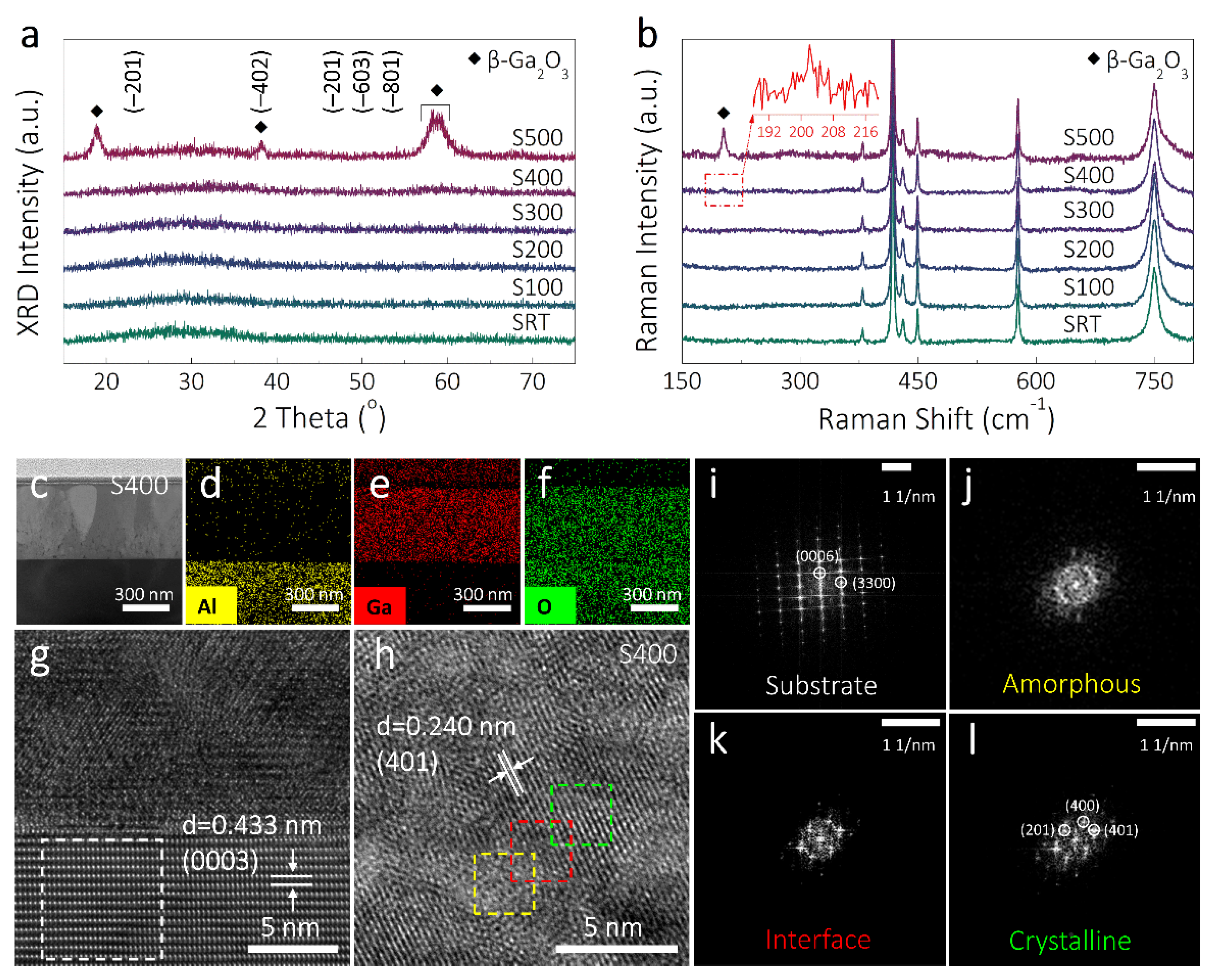
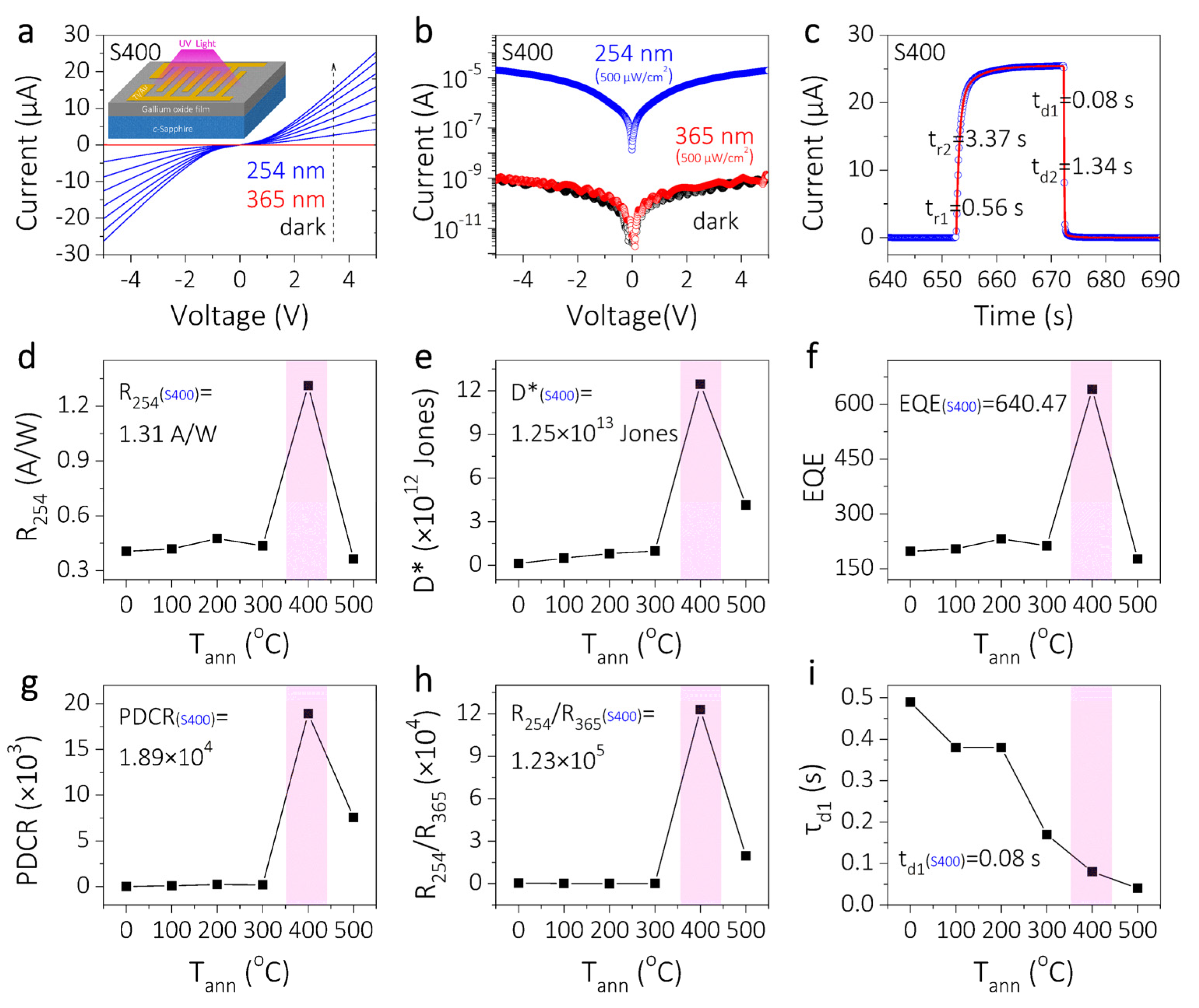
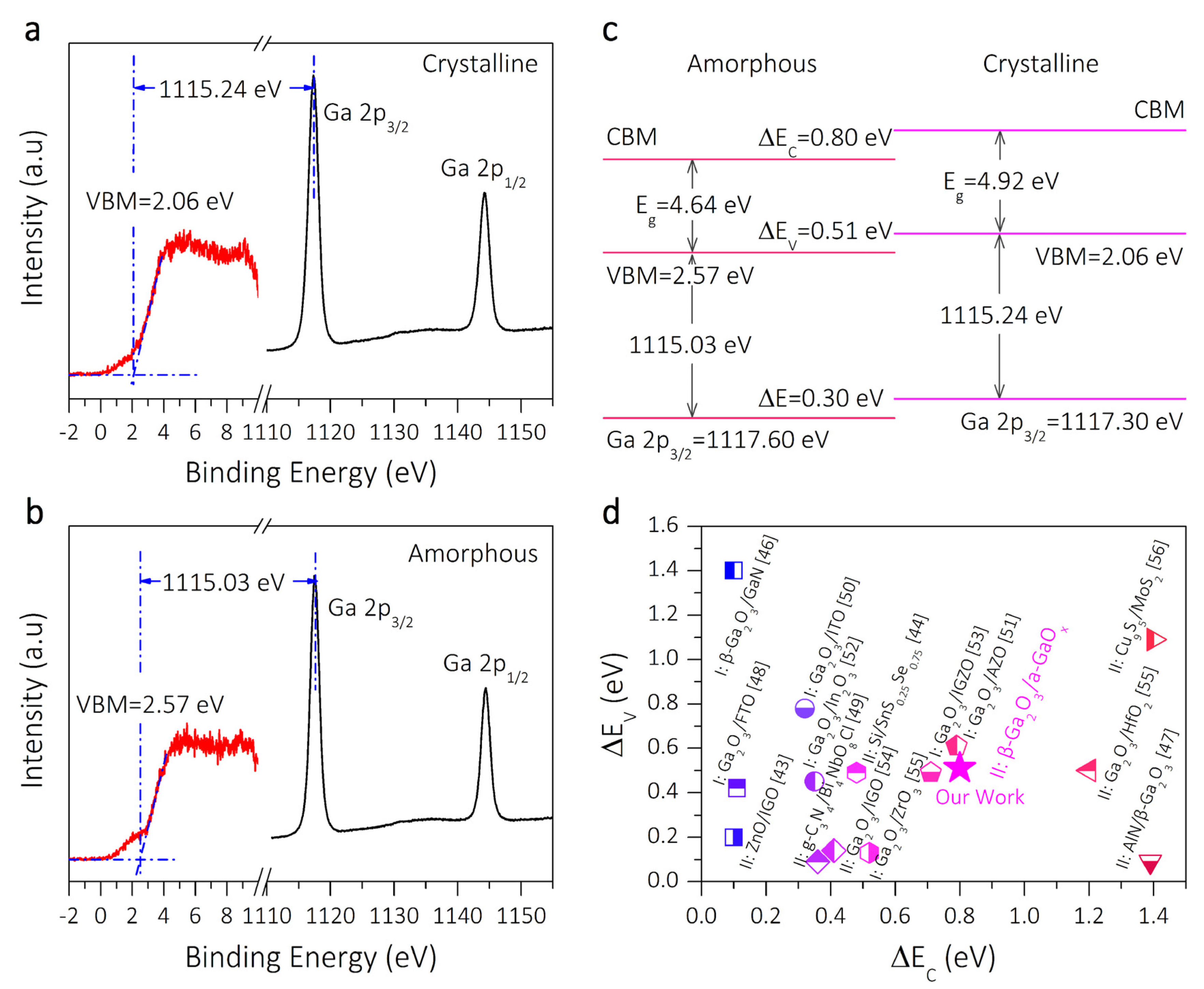
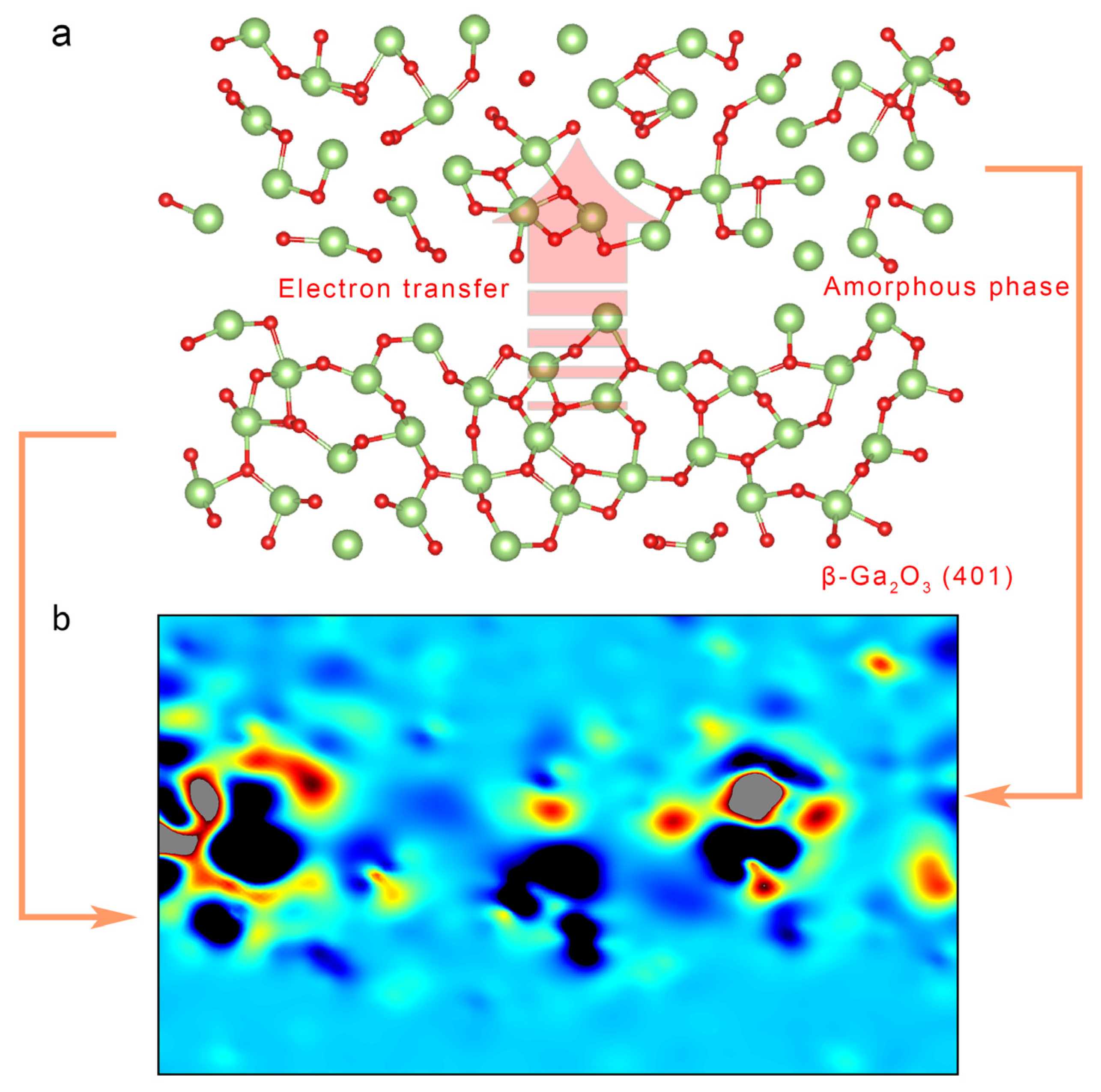

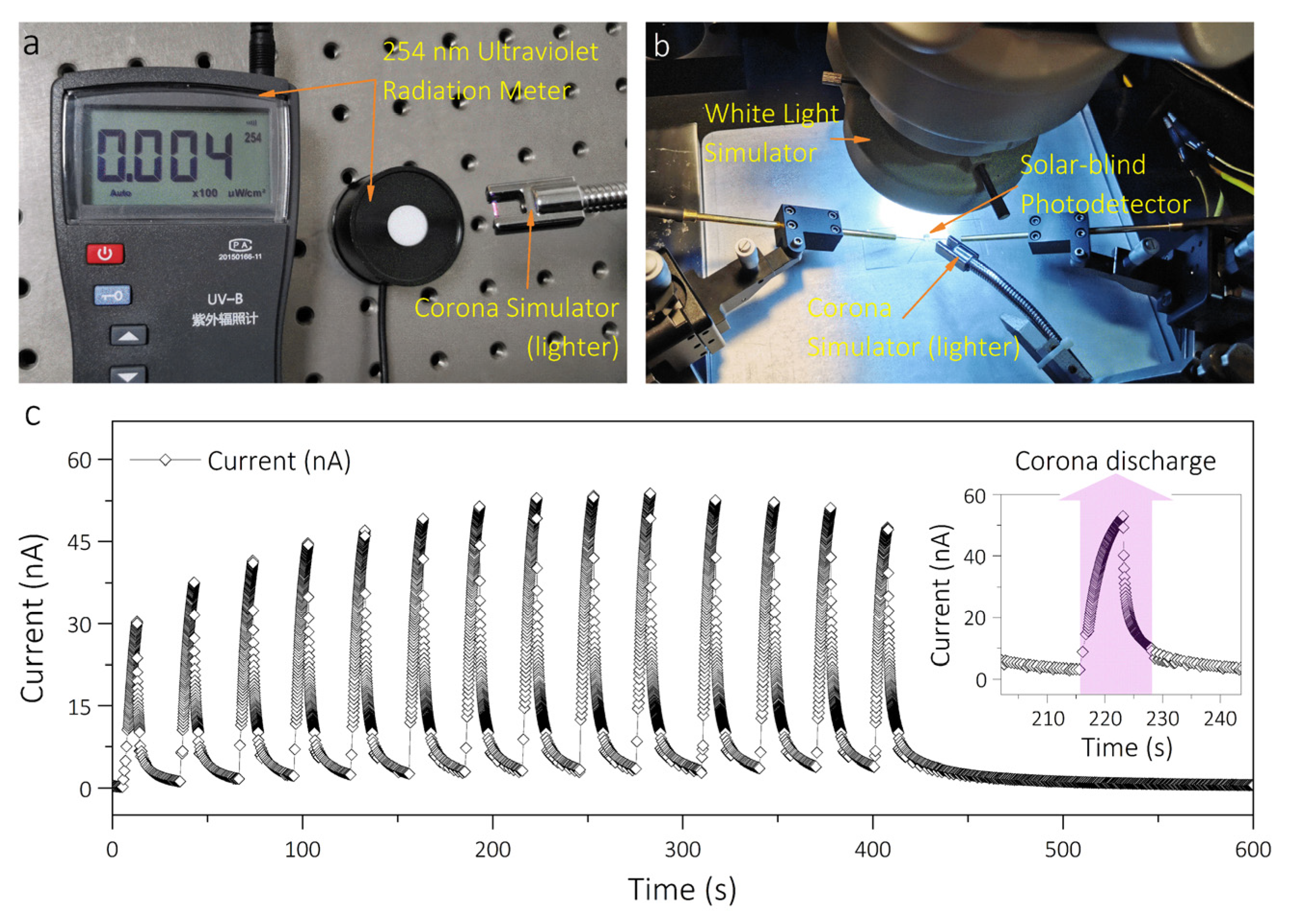
| Materials | Structures | Responsivity (A/W) | Detectivity (Jones) | EQE (%) | PDCR | Rejection Ratio | Decay Time (s) | Ref. |
|---|---|---|---|---|---|---|---|---|
| a-GaOx/β-Ga2O3 | MSM | 1.31 | 1.34 × 1013 | 6.4 × 102 | 2.21 × 104 | 1.2 × 105 | 0.08 | This work |
| Ga2O3 | MSM | 3.30 | 4.00 × 1012 | 1.6 × 103 | 10 | 2.0 × 103 | 0.02 | [13] |
| Ga2O3 | MSM | 26 | 1.25 × 1013 | 1.4 × 104 | 104 | 3.0 × 102 | 0.18 | [14] |
| Ga2O3 | MSM | 29.80 | 1.00 × 1012 | - | 103 | 9.4 × 103 | - | [42] |
| a-/c-Ga2O3 | MSM | 0.81 | 5.67 × 1014 | 4.0 × 102 | 1.2 × 107 | 8.1 × 105 | 2 × 10−5 | [30] |
| Diamond/Ga2O3 | MSM | 0.20 | 6.90 × 109 | - | 242 | 1.2 × 102 | - | [11] |
| Ga2O3: Mn | MSM | 0.07 | - | 3.6 × 101 | 67 | - | 0.03 | [43] |
| MoS2/Ga2O3 | Heterojunction | 2.05 | 1.21 × 1011 | - | 670 | 1.6 × 103 | - | [44] |
| ZnO/Ga2O3 | Heterojunction | 9.70 | 6.29 × 1012 | - | >104 | 6.9 × 102 | 0.09 | [45] |
| ZnO: Ga/Ga2O3 | Heterojunction | 3.73 | - | - | >102 | 102 | 0.272 | [46] |
| SnO2/CuZnS | Heterojunction | 0.0016 | 5.41 × 1011 | - | 1.3 × 103 | - | 0.001 | [47] |
| GaN/Ga2O3: Sn | p-n | 3.05 | 1.69 × 1013 | - | ~104 | 5.9 × 103 | 0.018 | [48] |
| CuSCN/Ga2O3 | p-n | 0.0013 | 9.43 × 1011 | - | 4.14 × 104 | 1.2 × 104 | 0.035 | [49] |
| Graphene/Ga2O3 | Schottky | 39.30 | 5.92 × 1013 | 2.0 × 104 | 3.40 × 102 | - | 219 | [20] |
| p-Gr/AlN | Schottky | 0.067 | - | 4.3 × 101 | 103 | 103 | 4 × 10−4 | [50] |
Publisher’s Note: MDPI stays neutral with regard to jurisdictional claims in published maps and institutional affiliations. |
© 2021 by the authors. Licensee MDPI, Basel, Switzerland. This article is an open access article distributed under the terms and conditions of the Creative Commons Attribution (CC BY) license (https://creativecommons.org/licenses/by/4.0/).
Share and Cite
Liu, H.; Li, H.; Zhou, S.; Zhang, H.; Fan, S.; Cui, Y.; Kong, C.; Ye, L.; Xiong, Y.; Li, W. Transport Mechanism of Enhanced Performance in an Amorphous/Monoclinic Mixed-Phase Ga2O3 Solar-Blind Deep Ultraviolet Photodetector. Crystals 2021, 11, 1111. https://doi.org/10.3390/cryst11091111
Liu H, Li H, Zhou S, Zhang H, Fan S, Cui Y, Kong C, Ye L, Xiong Y, Li W. Transport Mechanism of Enhanced Performance in an Amorphous/Monoclinic Mixed-Phase Ga2O3 Solar-Blind Deep Ultraviolet Photodetector. Crystals. 2021; 11(9):1111. https://doi.org/10.3390/cryst11091111
Chicago/Turabian StyleLiu, Haowen, Honglin Li, Shuren Zhou, Hong Zhang, Shiqiang Fan, Yuting Cui, Chunyang Kong, Lijuan Ye, Yuanqiang Xiong, and Wanjun Li. 2021. "Transport Mechanism of Enhanced Performance in an Amorphous/Monoclinic Mixed-Phase Ga2O3 Solar-Blind Deep Ultraviolet Photodetector" Crystals 11, no. 9: 1111. https://doi.org/10.3390/cryst11091111
APA StyleLiu, H., Li, H., Zhou, S., Zhang, H., Fan, S., Cui, Y., Kong, C., Ye, L., Xiong, Y., & Li, W. (2021). Transport Mechanism of Enhanced Performance in an Amorphous/Monoclinic Mixed-Phase Ga2O3 Solar-Blind Deep Ultraviolet Photodetector. Crystals, 11(9), 1111. https://doi.org/10.3390/cryst11091111









